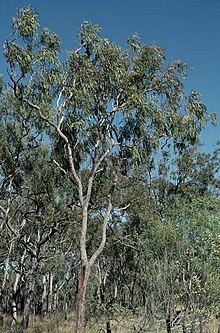| Rusty bloodwood | |
|---|---|

| |
| Scientific classification | |
| Kingdom: | Plantae |
| Clade: | Tracheophytes |
| Clade: | Angiosperms |
| Clade: | Eudicots |
| Clade: | Rosids |
| Order: | Myrtales |
| Family: | Myrtaceae |
| Genus: | Corymbia |
| Species: | C. umbonata |
| Binomial name | |
| Corymbia umbonata (D.J.Carr & S.G.M.Carr) K.D.Hill & L.A.S.Johnson | |
| Synonyms | |
| |


Corymbia umbonata, commonly known as rusty bloodwood, is a species of tree that is endemic to the Top End of the Northern Territory. It has thin, rough bark on the trunk, often also the branches, lance-shaped or curved adult leaves, flower buds in groups of seven, creamy white flowers and urn-shaped fruit.
Description
Corymbia umbonata is a tree that typically grows to a height of 17 m (56 ft) and forms a lignotuber. It has thin, rough, tessellated bark on the trunk, often also on the branches, smooth creamy pink to pale grey bark above. Young plants and coppice regrowth have egg-shaped to elliptical leaves that are 55–150 mm (2.2–5.9 in) long, 25–55 mm (0.98–2.17 in) wide and petiolate. Adult leaves are lance-shaped or curved, 90–230 mm (3.5–9.1 in) long and 8–20 mm (0.31–0.79 in) wide, tapering to a petiole 14–40 mm (0.55–1.57 in) long. The flower buds are arranged on the ends of branchlets on a branched peduncle 2–11 mm (0.079–0.433 in) long, each branch of the peduncle 55–150 mm (2.2–5.9 in) long and 25–55 mm (0.98–2.17 in) wide, usually with seven buds on pedicels 3–13 mm (0.12–0.51 in) long. Mature buds are oval to pear-shaped, 6–8 mm (0.24–0.31 in) long and 5–6 mm (0.20–0.24 in) wide with a rounded operculum. Flowering has been observed in March and April and the flowers are creamy white. The fruit is an urn-shaped capsule 12–19 mm (0.47–0.75 in) long and 11–16 mm (0.43–0.63 in) wide with the valves enclosed in the fruit.
Taxonomy and naming
The rusty bloodwood was first formally described in 1985 by Denis John Carr and Stella Grace Maisie Carr who gave it the name Eucalyptus umbonata and published the description in their book, Eucalyptus 1 - New or little-known species of the Corymbosae. The type specimens were collected by Laurence Adams near Katherine in 1964. In 1995, Ken Hill and Lawrie Johnson changed the name to Corymbia umbonata, publishing the change in the journal Telopea.
Distribution and habitat
Corymbia umbonata grows in open forest and savannah woodland in the Top End of the Northern Territory, including in the Judbarra / Gregory, Kakadu and Nitmiluk National Parks.
See also
References
- ^ "Corymbia umbonata". Australian Plant Census. Retrieved 29 February 2020.
- ^ "Corymbia umbonata (D.J.Carr & S.G.M.Carr) K.D.Hill & L.A.S.Johnson". NT Flora. Northern Territory Government. Retrieved 13 October 2016.
- ^ "Corymbia umbonata Rusty bloodwood". Euclid: Centre for Australian National Biodiversity Research. Retrieved 29 February 2020.
- ^ Hill, Kenneth D.; Johnson, Lawrence A.S. (1995). "Systematic studies in the eucalypts. 7. A revision of the bloodwoods, genus Corymbia (Myrtaceae)". Telopea. 6 (2–3): 300–301. doi:10.7751/telopea19953017.
- ^ Chippendale, George M. "Eucalyptus umbonata". Australian Biological Resources Study, Department of Agriculture, Water and the Environment, Canberra. Retrieved 29 February 2020.
- "Eucalyptus umbonata". APNI. Retrieved 29 February 2020.
- "Adams, Laurence George (Laurie) (1929–2014)". Council of Heads of Australasian Herbaria Australian National Herbarium. Retrieved 29 February 2020.
- "Corymbia umbonata". APNI. Retrieved 27 February 2020.
| Taxon identifiers | |
|---|---|
| Corymbia umbonata |
|
| Eucalyptus umbonata | |